Related Research Articles

Aaron Douglas was an American painter, illustrator, and visual arts educator. He was a major figure in the Harlem Renaissance. He developed his art career painting murals and creating illustrations that addressed social issues around race and segregation in the United States by utilizing African-centric imagery. Douglas set the stage for young, African-American artists to enter the public-arts realm through his involvement with the Harlem Artists Guild. In 1944, he concluded his art career by founding the Art Department at Fisk University in Nashville, Tennessee. He taught visual art classes at Fisk University until his retirement in 1966. Douglas is known as a prominent leader in modern African-American art whose work influenced artists for years to come.
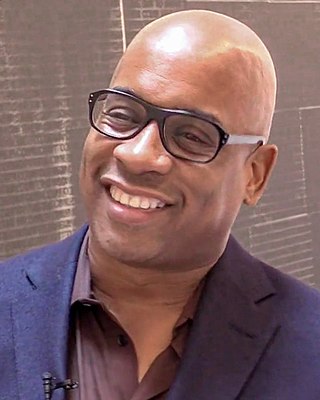
Glenn Ligon is an American conceptual artist whose work explores race, language, desire, sexuality, and identity. Based in New York City, Ligon's work often draws on 20th century literature and speech of 20th century cultural figures such as James Baldwin, Zora Neale Hurston, Gertrude Stein, Jean Genet, and Richard Pryor. He is noted as one of the originators of the term Post-Blackness.
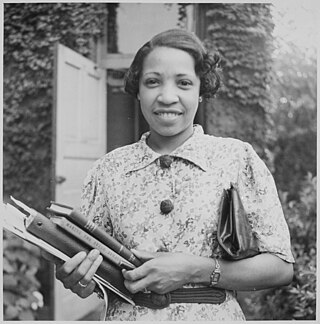
Lois Mailou Jones (1905–1998) was an artist and educator. Her work can be found in the collections of the Smithsonian American Art Museum, The Metropolitan Museum of Art, the National Museum of Women in the Arts, the Brooklyn Museum, the Museum of Fine Arts, Boston, Muscarelle Museum of Art, and The Phillips Collection. She is often associated with the Harlem Renaissance.

David C. Driskell was an American artist, scholar and curator; recognized for his work in establishing African-American Art as a distinct field of study. In his lifetime, Driskell was cited as one of the world's leading authorities on the subject of African-American Art. Driskell held the title of Distinguished University Professor of Art, Emeritus, at the University of Maryland, College Park. The David C. Driskell Center at the University of Maryland, is named in his honor.

Alma Woodsey Thomas was an African-American artist and teacher who lived and worked in Washington, D.C., and is now recognized as a major American painter of the 20th century. Thomas is best known for the "exuberant", colorful, abstract paintings that she created after her retirement from a 35-year career teaching art at Washington's Shaw Junior High School.
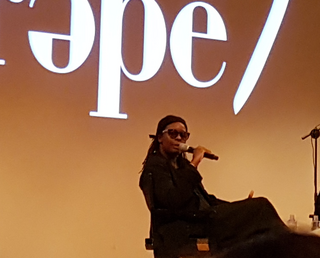
Mickalene Thomas is a contemporary African-American visual artist best known as a painter of complex works using rhinestones, acrylic, and enamel. Thomas's collage work is inspired from popular art histories and movements, including Impressionism, Cubism, Dada, the Harlem Renaissance, and selected works by the Afro-British painter Chris Ofili. Her work draws from Western art history, pop art, and visual culture to examine ideas around femininity, beauty, race, sexuality, and gender.
Renée Stout is an American sculptor and contemporary artist known for assemblage artworks dealing with her personal history and African-American heritage. Born in Kansas, raised in Pittsburgh, living in Washington, D.C., and connected through her art to New Orleans, her art reflects this interest in African diasporic culture throughout the United States. Stout was the first American artist to exhibit in the Smithsonian's National Museum of African Art.
Kerry James Marshall is an American artist and professor, known for his paintings of Black figures. He previously taught painting at the School of Art and Design at the University of Illinois at Chicago. In 2017, Marshall was included on the annual Time 100 list of the most influential people in the world. He was born and raised in Birmingham, Alabama, and moved in childhood to South Central Los Angeles. He has spent much of his career in Chicago, Illinois.

Pat Steir is an American painter and printmaker. Her early work was loosely associated with conceptual art and minimalism, however, she is best known for her abstract dripped, splashed and poured "Waterfall" paintings, which she started in the 1980s, and for her later site-specific wall drawings.
Sylvia Snowden is an African American abstract painter who works with acrylics, oil pastels, and mixed media to create textured works that convey the "feel of paint". Many museums have hosted her art in exhibits, while several have added her works to their permanent collections.
William T. Williams is an American painter and educator. He is known for his process-based approach to painting that engages motifs drawn from personal memory and cultural narrative to create non-referential, abstract compositions. He was a Professor of Art at Brooklyn College, City University of New York from 1971 to 2008.

Joyce J. Scott is an African-American artist, sculptor, quilter, performance artist, installation artist, print-maker, lecturer and educator. Named a MacArthur Fellow in 2016, and a Smithsonian Visionary Artist in 2019, Scott is best known for her figurative sculptures and jewelry using free form, off-loom beadweaving techniques, similar to a peyote stitch. Each piece is often constructed using thousands of glass seed beads or pony beads, and sometimes other found objects or materials such as glass, quilting and leather. In 2018, she was hailed for working in new medium — a mixture of soil, clay, straw, and cement — for a sculpture meant to disintegrate and return to the earth. Scott is influenced by a variety of diverse cultures, including Native American and African traditions, Mexican, Czech, and Russian beadwork, illustration and comic books, and pop culture.

Edward Leroy Loper Sr. was an African American artist and teacher from Delaware, best known for his vibrant palette and juxtaposition of colors. He taught painting for almost 70 years.
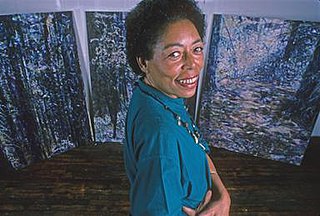
Vivian E. Browne was an American artist. Born in Laurel, Florida, Browne was mostly known for her painting series called Little Men and her Africa series. She is also known for linking abstraction to nature in her tree paintings and in a series of abstract works made with layers of silk that were influenced by her travels to China. She was an activist, professor, and has received multiple awards for her work. According to her mother, Browne died at age 64 from bladder cancer.
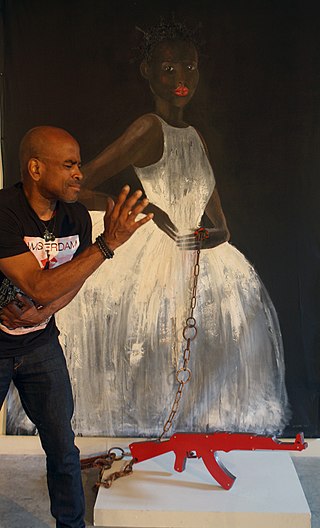
Willie Little is a conceptual, multimedia, installation artist and storyteller, whose work is strongly influenced by traditions of rural North Carolina.
Torkwase Dyson is an interdisciplinary artist based in Beacon, New York, United States. Dyson describes the themes of her work as "architecture, infrastructure, environmental justice, and abstract drawing." Her work is informed by her own theory of Black Compositional Thought. This working term considers how spatial networks—paths, throughways, water, architecture, and geographies—are composed by Black bodies as a means of exploring potential networks for Black liberation. She is represented by Pace Gallery and Richard Gray Gallery.
Barbara Tyson Mosley is an American artist, known for her abstract landscape paintings, mix media artwork, photography, and fiber art. She is active in Louisville, Kentucky and within the Black community.

Francine Haskins, a Washington, D.C. native, is an American multi-media fiber artist and book illustrator. She was one of the original founders of 1800 Belmont Arts, an African- American black art collective in Washington, D.C. (1991-–2001).

Samuel Joseph Brown Jr. (1907–1994) was a watercolorist, printmaker, and educator. He was the first African American artist hired to produce work for the Public Works of Art Project, a precursor to the Work Progress Administration's Federal Art Project. Brown often depicted the lives of African Americans in his paintings. He worked primarily in watercolor and oils, and he produced portraits, landscapes and prints.
Barbara J. Bullock is an African American painter, collagist, printmaker, soft sculptor and arts instructor. Her works capture African motifs, African and African American culture, spirits, dancing and jazz in abstract and figural forms. She creates three-dimensional collages, portraits, altars and masks in vibrant colors, patterns and shapes. Bullock produces artworks in series with a common theme and style.
References
- 1 2 3 "Shrine to Beauty: Filo Sofi Arts Opens in Cranford, New Jersey". Whitehot Magazine of Contemporary Art. Retrieved 2022-04-23.
- 1 2 "The Fluid Artistic Dynamics of Kimberly Camp". BLACK ART IN AMERICA™. 2021-12-18. Retrieved 2022-04-23.
- 1 2 3 Armstrong, Jenice. "Celebrating Success: A gallery of her own". www.inquirer.com. Retrieved 2022-04-23.
- 1 2 3 Nicole, Terina (2017-02-28). "Makers Series: Interview with Professor/Multi-Media Artist/Gallery Owner Kimberly Camp". terinanicoledesign. Retrieved 2022-04-23.
- 1 2 "For Lifelong Artist Kimberly Camp, Art is Life". The Craftsmanship Initiative. Retrieved 2022-04-23.
- ↑ Arts, National Endowment for the (1994). Annual Report. Division of Publications, National Endowment for the Arts. p. 35.
- 1 2 3 4 Meyers, Mary Ann (2017-09-08). Art, Education, and African-American Culture: Albert Barnes and the Science of Philanthropy. Routledge. ISBN 978-1-351-32322-2.
- 1 2 3 Toda, Mitch (2018-07-05). "Designed for Change: The Experimental Gallery, 1991-1994". Smithsonian Institution Archives. Retrieved 2022-04-23.
- 1 2 Graves, Earl G. (1998). "Professional Spotlight: The Journey of an Artist". Black Enterprise. Earl G. Graves, Ltd. p. 58.
- ↑ Niekrasz, Emily (2019-08-21). "Wonderful Women Wednesday: Kimberly Camp". Smithsonian Institution Archives. Retrieved 2022-04-23.
- ↑ Walker-Kuhne, Donna (2005-09-06). Invitation to the Party: Building Bridges to the Arts, Culture and Community. Theatre Communications Group. p. 139. ISBN 978-1-55936-636-6.
- ↑ Lawson, Carol (1992-10-22). "Exhibition for Children About Racism". The New York Times. ISSN 0362-4331 . Retrieved 2022-04-23.
- ↑ "Black Culture Surveyed In Detroit Museum". The New York Times. 1997-04-20. ISSN 0362-4331 . Retrieved 2023-04-05.
- ↑ Salisbury, Stephan. "Kimberly Camp faced hostile neighbors, budget deficit in running Barne". www.inquirer.com. Retrieved 2022-04-23.
- ↑ deco, ART | library (2017-12-12). "ArtProfession: Black Art in America Talks with Kimberly Camp about Mentorship and Pursuing a Career in Arts Administration". ART | library deco. Retrieved 2022-04-23.
- ↑ "Barnes Foundation".
- ↑ McCalla, John (April 26, 1999). "Canvassing for dollars". www.bizjournals.com. Retrieved 2022-04-23.
- 1 2 "Battle for the Barnes". The New Yorker. 2002-01-14. Retrieved 2022-04-23.
- 1 2 "The Barnes move 5 years later: (essentially, 'we were right')". PhillyVoice. 2017-10-07. Retrieved 2022-04-23.
- ↑ Perl, Jed (2012-08-24). "The Barnes Foundation's Disastrous New Home". The New Republic. ISSN 0028-6583 . Retrieved 2022-04-23.
- ↑ "Kimberly Camp on mentorship and pursuing a career in arts administration". BLACK ART IN AMERICA™. 2017-11-20. Retrieved 2022-04-23.
- ↑ "The Fluid Artistic Dynamics of Kimberly Camp". BLACK ART IN AMERICA™. 2021-12-18. Retrieved 2023-04-05.
- ↑ Riordan, Kevin. "Getting to know a kinder, gentler Albert C. Barnes". Philly Inquirer. Retrieved 2022-04-23.
- ↑ Boatman, Gail T. "Ex-Barnes president returns to roots". Bucks County Courier Times. Retrieved 2022-04-23.
- ↑ "'Art Of The Steal': Actual Heist Or Conspiracy Theory?". NPR.org. Retrieved 2022-04-23.
- 1 2 Staff, the Hour (2016-04-22). "20/20 Hindsight". Hour Detroit Magazine. Retrieved 2022-04-23.
- 1 2 3 "Kimberly Camp | InLiquid" . Retrieved 2022-04-23.
- ↑ "Kimberly Camp, Everyday Genius". Da Vinci Art Alliance. Retrieved 2022-04-23.
- ↑ Boatman, Gail T. "The art of the comeback". Burlington County Times. Retrieved 2022-04-23.
- ↑ "Record Kimberly Camp papers, 1970-2015 | Collections Search Center, Smithsonian Institution". collections.si.edu. Retrieved 2022-04-23.
- ↑ "Bloomberg Grant to Transform Camden Lots to Public Art Space | WNYC | New York Public Radio, Podcasts, Live Streaming Radio, News". WNYC. Retrieved 2023-04-05.
- 1 2 3 4 5 Nzegwu, Nkiru (1993). Uncommon Beauty in Common Objects: The Legacy of African American Craft Art. National Afro-American Museum and Cultural Center. pp. 36–37. ISBN 978-1-880179-03-1.
- 1 2 "Filo Sofi Arts — Exhibition: Spirit Guides". Filo Sofi Arts. Retrieved 2022-04-23.
- ↑ Letters, Black Academy of Arts and (January 2006). "[Flyer: African American Dolls: The Work of Kimberly Camp]". The Portal to Texas History. Retrieved 2022-04-23.
- 1 2 "Kimberly Camp". Museum of Craft Design.
- 1 2 Ebony. Johnson Publishing Company. December 2007. p. 182.
- 1 2 "Disclosures: Kimberly Camp, or Life Between the Parallels". Whitehot Magazine of Contemporary Art. Retrieved 2022-04-23.
- 1 2 "Kimberly Camp". National Geographic World . December 1986. p. 22.
- ↑ "2020 Encore Awards". South Jersey Cultural Alliance. Archived from the original on 2021-08-04. Retrieved 2022-04-23.
- ↑ "Kimberly Camp – Visual, Media, and Performing Arts". vmpa.camden.rutgers.edu. Retrieved 2022-04-23.